Project Charter for Mobile Based Farmer Support Application
VerifiedAdded on 2022/11/13
|13
|2585
|272
AI Summary
This report aims to develop a project charter for the proposed mobile based farmer support application (MBFSA). The report details the project background, identifies Measurable Organizational Value (MOV) of the project, defines the scope, and outline Quality and risk management plans, as well as a Work Breakdown Structure (WBS) for the project.
Contribute Materials
Your contribution can guide someone’s learning journey. Share your
documents today.

Project Charter
Student ID
Name
Lecturer details
Student ID
Name
Lecturer details
Secure Best Marks with AI Grader
Need help grading? Try our AI Grader for instant feedback on your assignments.
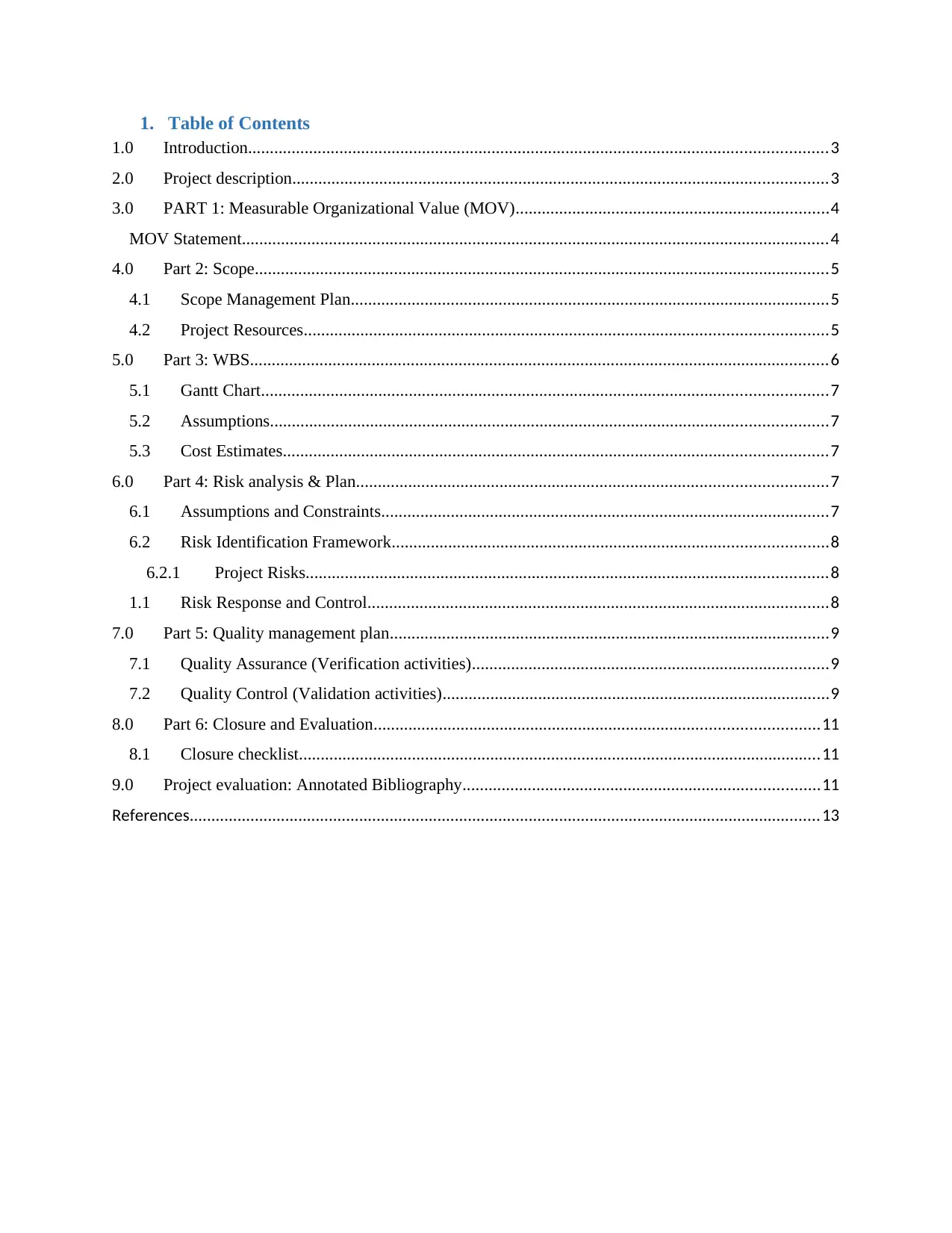
1. Table of Contents
1.0 Introduction.....................................................................................................................................3
2.0 Project description...........................................................................................................................3
3.0 PART 1: Measurable Organizational Value (MOV)........................................................................4
MOV Statement.......................................................................................................................................4
4.0 Part 2: Scope....................................................................................................................................5
4.1 Scope Management Plan..............................................................................................................5
4.2 Project Resources........................................................................................................................5
5.0 Part 3: WBS.....................................................................................................................................6
5.1 Gantt Chart..................................................................................................................................7
5.2 Assumptions................................................................................................................................7
5.3 Cost Estimates.............................................................................................................................7
6.0 Part 4: Risk analysis & Plan............................................................................................................7
6.1 Assumptions and Constraints.......................................................................................................7
6.2 Risk Identification Framework....................................................................................................8
6.2.1 Project Risks........................................................................................................................8
1.1 Risk Response and Control..........................................................................................................8
7.0 Part 5: Quality management plan.....................................................................................................9
7.1 Quality Assurance (Verification activities)..................................................................................9
7.2 Quality Control (Validation activities).........................................................................................9
8.0 Part 6: Closure and Evaluation......................................................................................................11
8.1 Closure checklist........................................................................................................................11
9.0 Project evaluation: Annotated Bibliography..................................................................................11
References.................................................................................................................................................13
1.0 Introduction.....................................................................................................................................3
2.0 Project description...........................................................................................................................3
3.0 PART 1: Measurable Organizational Value (MOV)........................................................................4
MOV Statement.......................................................................................................................................4
4.0 Part 2: Scope....................................................................................................................................5
4.1 Scope Management Plan..............................................................................................................5
4.2 Project Resources........................................................................................................................5
5.0 Part 3: WBS.....................................................................................................................................6
5.1 Gantt Chart..................................................................................................................................7
5.2 Assumptions................................................................................................................................7
5.3 Cost Estimates.............................................................................................................................7
6.0 Part 4: Risk analysis & Plan............................................................................................................7
6.1 Assumptions and Constraints.......................................................................................................7
6.2 Risk Identification Framework....................................................................................................8
6.2.1 Project Risks........................................................................................................................8
1.1 Risk Response and Control..........................................................................................................8
7.0 Part 5: Quality management plan.....................................................................................................9
7.1 Quality Assurance (Verification activities)..................................................................................9
7.2 Quality Control (Validation activities).........................................................................................9
8.0 Part 6: Closure and Evaluation......................................................................................................11
8.1 Closure checklist........................................................................................................................11
9.0 Project evaluation: Annotated Bibliography..................................................................................11
References.................................................................................................................................................13
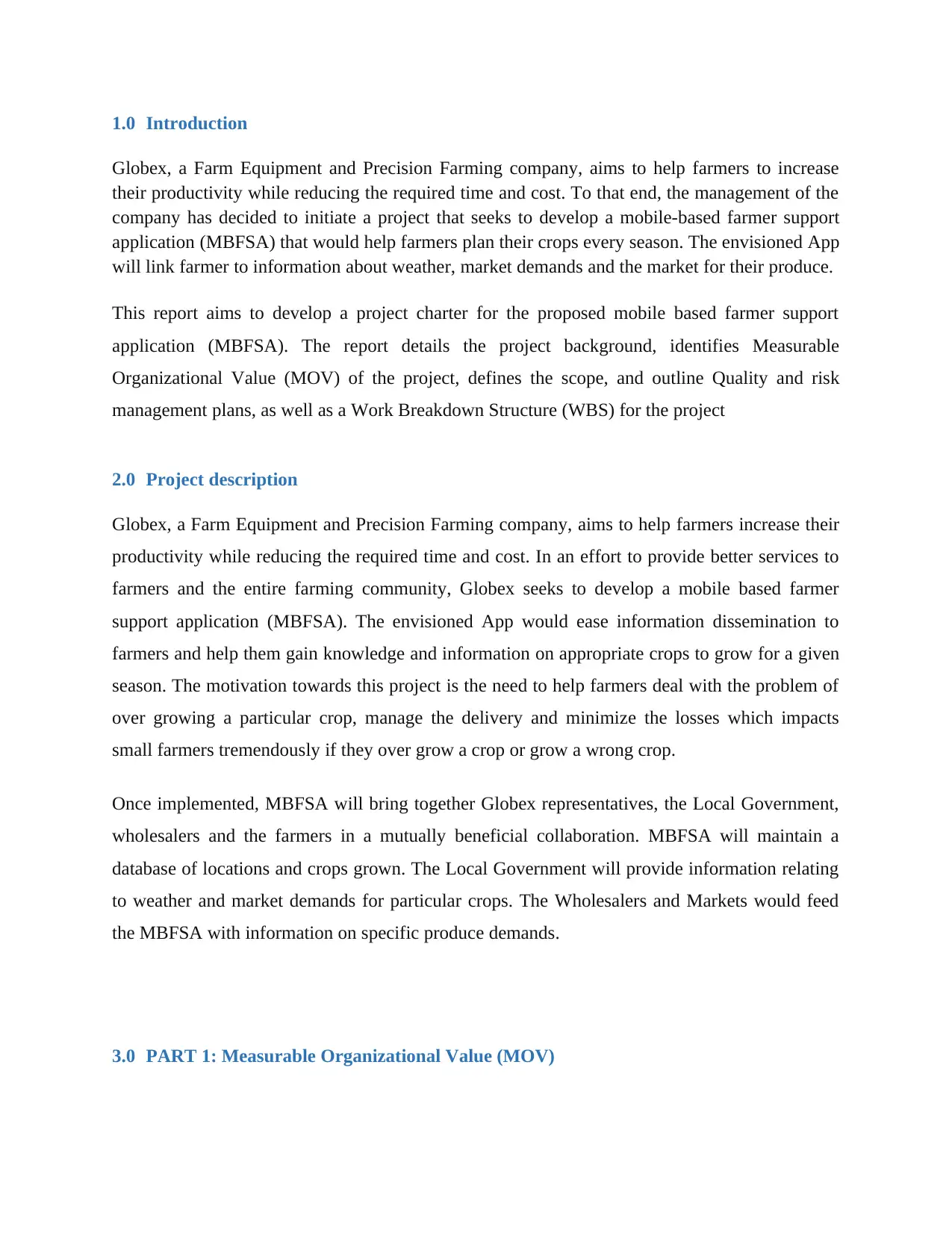
1.0 Introduction
Globex, a Farm Equipment and Precision Farming company, aims to help farmers to increase
their productivity while reducing the required time and cost. To that end, the management of the
company has decided to initiate a project that seeks to develop a mobile-based farmer support
application (MBFSA) that would help farmers plan their crops every season. The envisioned App
will link farmer to information about weather, market demands and the market for their produce.
This report aims to develop a project charter for the proposed mobile based farmer support
application (MBFSA). The report details the project background, identifies Measurable
Organizational Value (MOV) of the project, defines the scope, and outline Quality and risk
management plans, as well as a Work Breakdown Structure (WBS) for the project
2.0 Project description
Globex, a Farm Equipment and Precision Farming company, aims to help farmers increase their
productivity while reducing the required time and cost. In an effort to provide better services to
farmers and the entire farming community, Globex seeks to develop a mobile based farmer
support application (MBFSA). The envisioned App would ease information dissemination to
farmers and help them gain knowledge and information on appropriate crops to grow for a given
season. The motivation towards this project is the need to help farmers deal with the problem of
over growing a particular crop, manage the delivery and minimize the losses which impacts
small farmers tremendously if they over grow a crop or grow a wrong crop.
Once implemented, MBFSA will bring together Globex representatives, the Local Government,
wholesalers and the farmers in a mutually beneficial collaboration. MBFSA will maintain a
database of locations and crops grown. The Local Government will provide information relating
to weather and market demands for particular crops. The Wholesalers and Markets would feed
the MBFSA with information on specific produce demands.
3.0 PART 1: Measurable Organizational Value (MOV)
Globex, a Farm Equipment and Precision Farming company, aims to help farmers to increase
their productivity while reducing the required time and cost. To that end, the management of the
company has decided to initiate a project that seeks to develop a mobile-based farmer support
application (MBFSA) that would help farmers plan their crops every season. The envisioned App
will link farmer to information about weather, market demands and the market for their produce.
This report aims to develop a project charter for the proposed mobile based farmer support
application (MBFSA). The report details the project background, identifies Measurable
Organizational Value (MOV) of the project, defines the scope, and outline Quality and risk
management plans, as well as a Work Breakdown Structure (WBS) for the project
2.0 Project description
Globex, a Farm Equipment and Precision Farming company, aims to help farmers increase their
productivity while reducing the required time and cost. In an effort to provide better services to
farmers and the entire farming community, Globex seeks to develop a mobile based farmer
support application (MBFSA). The envisioned App would ease information dissemination to
farmers and help them gain knowledge and information on appropriate crops to grow for a given
season. The motivation towards this project is the need to help farmers deal with the problem of
over growing a particular crop, manage the delivery and minimize the losses which impacts
small farmers tremendously if they over grow a crop or grow a wrong crop.
Once implemented, MBFSA will bring together Globex representatives, the Local Government,
wholesalers and the farmers in a mutually beneficial collaboration. MBFSA will maintain a
database of locations and crops grown. The Local Government will provide information relating
to weather and market demands for particular crops. The Wholesalers and Markets would feed
the MBFSA with information on specific produce demands.
3.0 PART 1: Measurable Organizational Value (MOV)
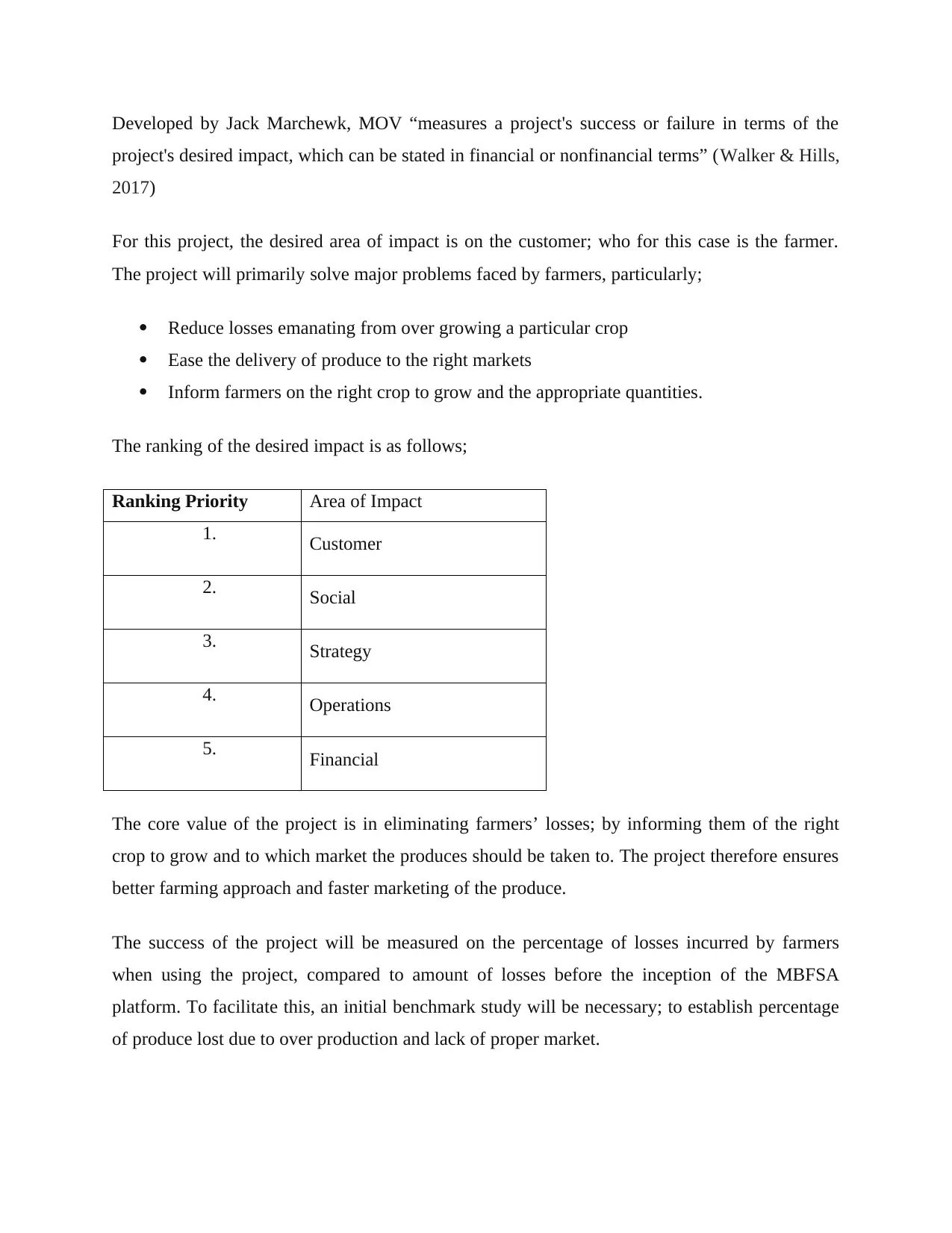
Developed by Jack Marchewk, MOV “measures a project's success or failure in terms of the
project's desired impact, which can be stated in financial or nonfinancial terms” (Walker & Hills,
2017)
For this project, the desired area of impact is on the customer; who for this case is the farmer.
The project will primarily solve major problems faced by farmers, particularly;
Reduce losses emanating from over growing a particular crop
Ease the delivery of produce to the right markets
Inform farmers on the right crop to grow and the appropriate quantities.
The ranking of the desired impact is as follows;
Ranking Priority Area of Impact
1. Customer
2. Social
3. Strategy
4. Operations
5. Financial
The core value of the project is in eliminating farmers’ losses; by informing them of the right
crop to grow and to which market the produces should be taken to. The project therefore ensures
better farming approach and faster marketing of the produce.
The success of the project will be measured on the percentage of losses incurred by farmers
when using the project, compared to amount of losses before the inception of the MBFSA
platform. To facilitate this, an initial benchmark study will be necessary; to establish percentage
of produce lost due to over production and lack of proper market.
project's desired impact, which can be stated in financial or nonfinancial terms” (Walker & Hills,
2017)
For this project, the desired area of impact is on the customer; who for this case is the farmer.
The project will primarily solve major problems faced by farmers, particularly;
Reduce losses emanating from over growing a particular crop
Ease the delivery of produce to the right markets
Inform farmers on the right crop to grow and the appropriate quantities.
The ranking of the desired impact is as follows;
Ranking Priority Area of Impact
1. Customer
2. Social
3. Strategy
4. Operations
5. Financial
The core value of the project is in eliminating farmers’ losses; by informing them of the right
crop to grow and to which market the produces should be taken to. The project therefore ensures
better farming approach and faster marketing of the produce.
The success of the project will be measured on the percentage of losses incurred by farmers
when using the project, compared to amount of losses before the inception of the MBFSA
platform. To facilitate this, an initial benchmark study will be necessary; to establish percentage
of produce lost due to over production and lack of proper market.
Secure Best Marks with AI Grader
Need help grading? Try our AI Grader for instant feedback on your assignments.
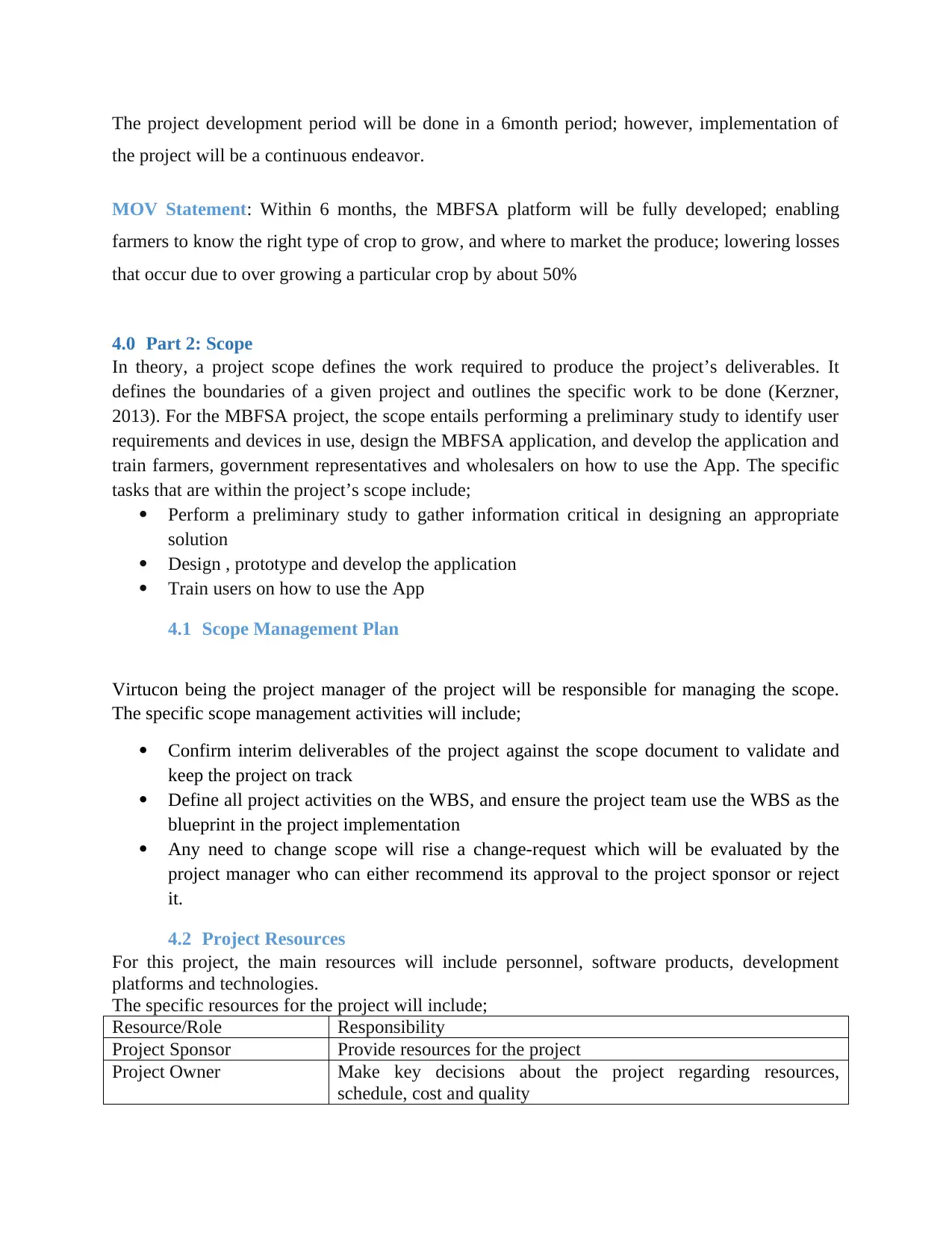
The project development period will be done in a 6month period; however, implementation of
the project will be a continuous endeavor.
MOV Statement: Within 6 months, the MBFSA platform will be fully developed; enabling
farmers to know the right type of crop to grow, and where to market the produce; lowering losses
that occur due to over growing a particular crop by about 50%
4.0 Part 2: Scope
In theory, a project scope defines the work required to produce the project’s deliverables. It
defines the boundaries of a given project and outlines the specific work to be done (Kerzner,
2013). For the MBFSA project, the scope entails performing a preliminary study to identify user
requirements and devices in use, design the MBFSA application, and develop the application and
train farmers, government representatives and wholesalers on how to use the App. The specific
tasks that are within the project’s scope include;
Perform a preliminary study to gather information critical in designing an appropriate
solution
Design , prototype and develop the application
Train users on how to use the App
4.1 Scope Management Plan
Virtucon being the project manager of the project will be responsible for managing the scope.
The specific scope management activities will include;
Confirm interim deliverables of the project against the scope document to validate and
keep the project on track
Define all project activities on the WBS, and ensure the project team use the WBS as the
blueprint in the project implementation
Any need to change scope will rise a change-request which will be evaluated by the
project manager who can either recommend its approval to the project sponsor or reject
it.
4.2 Project Resources
For this project, the main resources will include personnel, software products, development
platforms and technologies.
The specific resources for the project will include;
Resource/Role Responsibility
Project Sponsor Provide resources for the project
Project Owner Make key decisions about the project regarding resources,
schedule, cost and quality
the project will be a continuous endeavor.
MOV Statement: Within 6 months, the MBFSA platform will be fully developed; enabling
farmers to know the right type of crop to grow, and where to market the produce; lowering losses
that occur due to over growing a particular crop by about 50%
4.0 Part 2: Scope
In theory, a project scope defines the work required to produce the project’s deliverables. It
defines the boundaries of a given project and outlines the specific work to be done (Kerzner,
2013). For the MBFSA project, the scope entails performing a preliminary study to identify user
requirements and devices in use, design the MBFSA application, and develop the application and
train farmers, government representatives and wholesalers on how to use the App. The specific
tasks that are within the project’s scope include;
Perform a preliminary study to gather information critical in designing an appropriate
solution
Design , prototype and develop the application
Train users on how to use the App
4.1 Scope Management Plan
Virtucon being the project manager of the project will be responsible for managing the scope.
The specific scope management activities will include;
Confirm interim deliverables of the project against the scope document to validate and
keep the project on track
Define all project activities on the WBS, and ensure the project team use the WBS as the
blueprint in the project implementation
Any need to change scope will rise a change-request which will be evaluated by the
project manager who can either recommend its approval to the project sponsor or reject
it.
4.2 Project Resources
For this project, the main resources will include personnel, software products, development
platforms and technologies.
The specific resources for the project will include;
Resource/Role Responsibility
Project Sponsor Provide resources for the project
Project Owner Make key decisions about the project regarding resources,
schedule, cost and quality
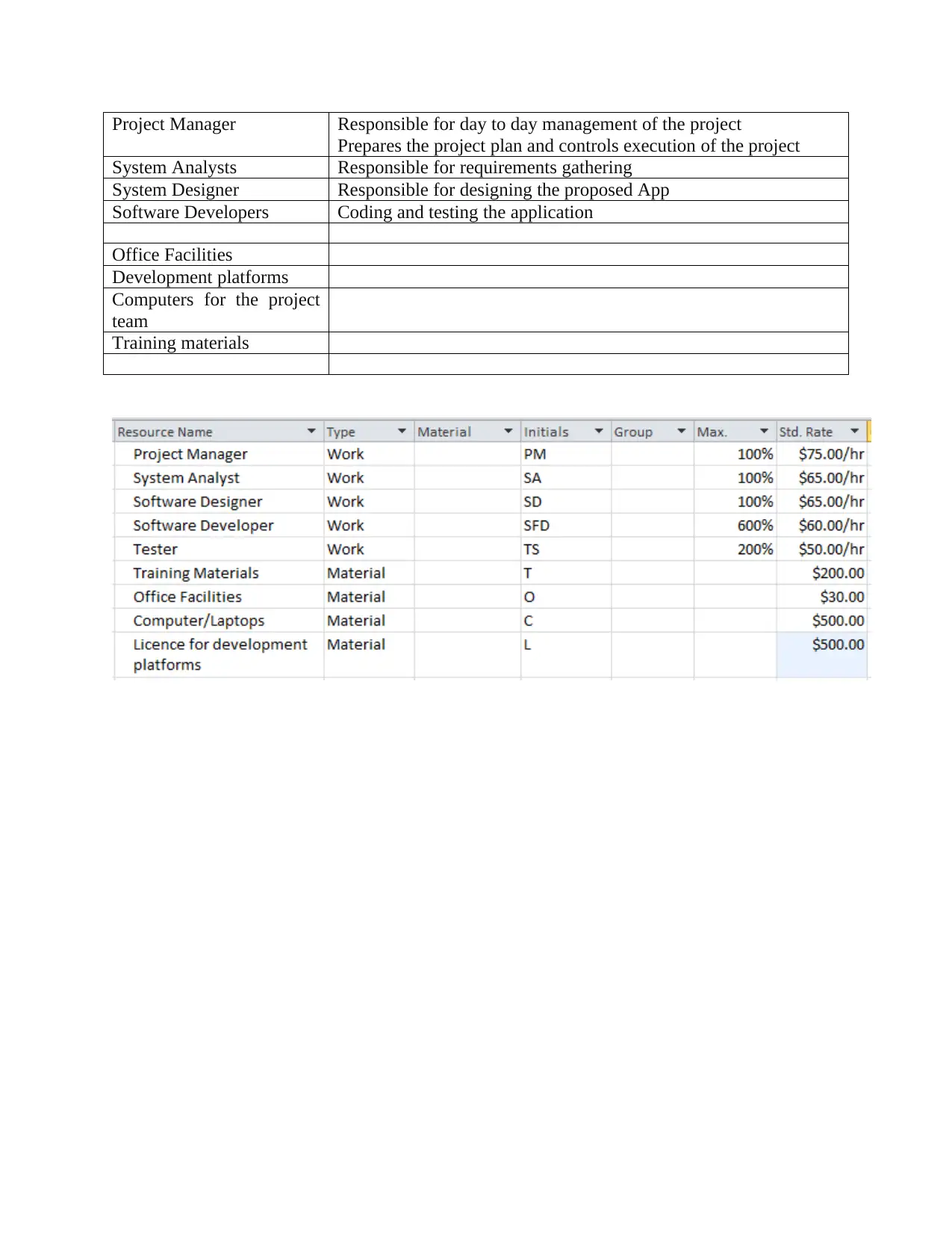
Project Manager Responsible for day to day management of the project
Prepares the project plan and controls execution of the project
System Analysts Responsible for requirements gathering
System Designer Responsible for designing the proposed App
Software Developers Coding and testing the application
Office Facilities
Development platforms
Computers for the project
team
Training materials
Prepares the project plan and controls execution of the project
System Analysts Responsible for requirements gathering
System Designer Responsible for designing the proposed App
Software Developers Coding and testing the application
Office Facilities
Development platforms
Computers for the project
team
Training materials
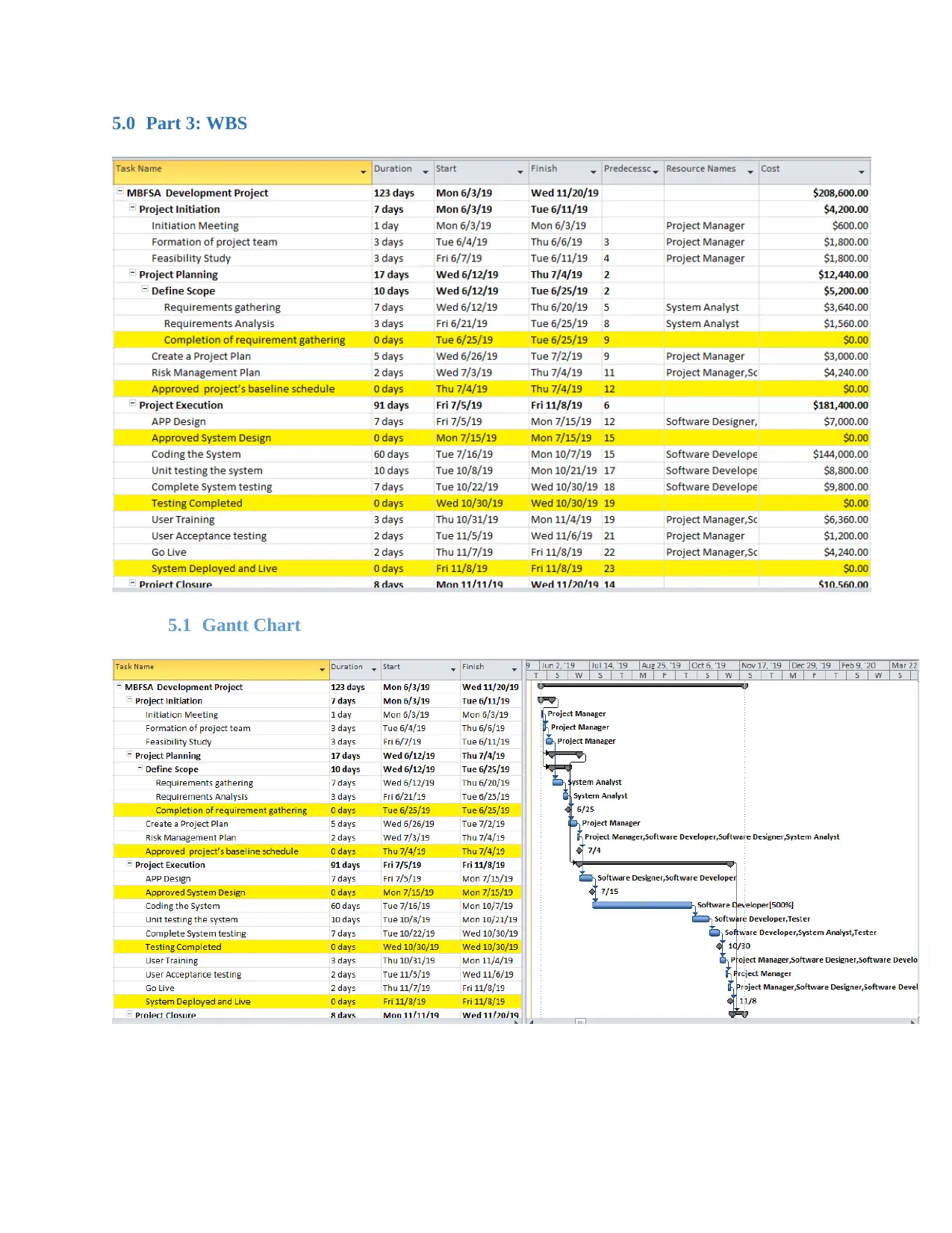
5.0 Part 3: WBS
5.1 Gantt Chart
5.1 Gantt Chart
Paraphrase This Document
Need a fresh take? Get an instant paraphrase of this document with our AI Paraphraser
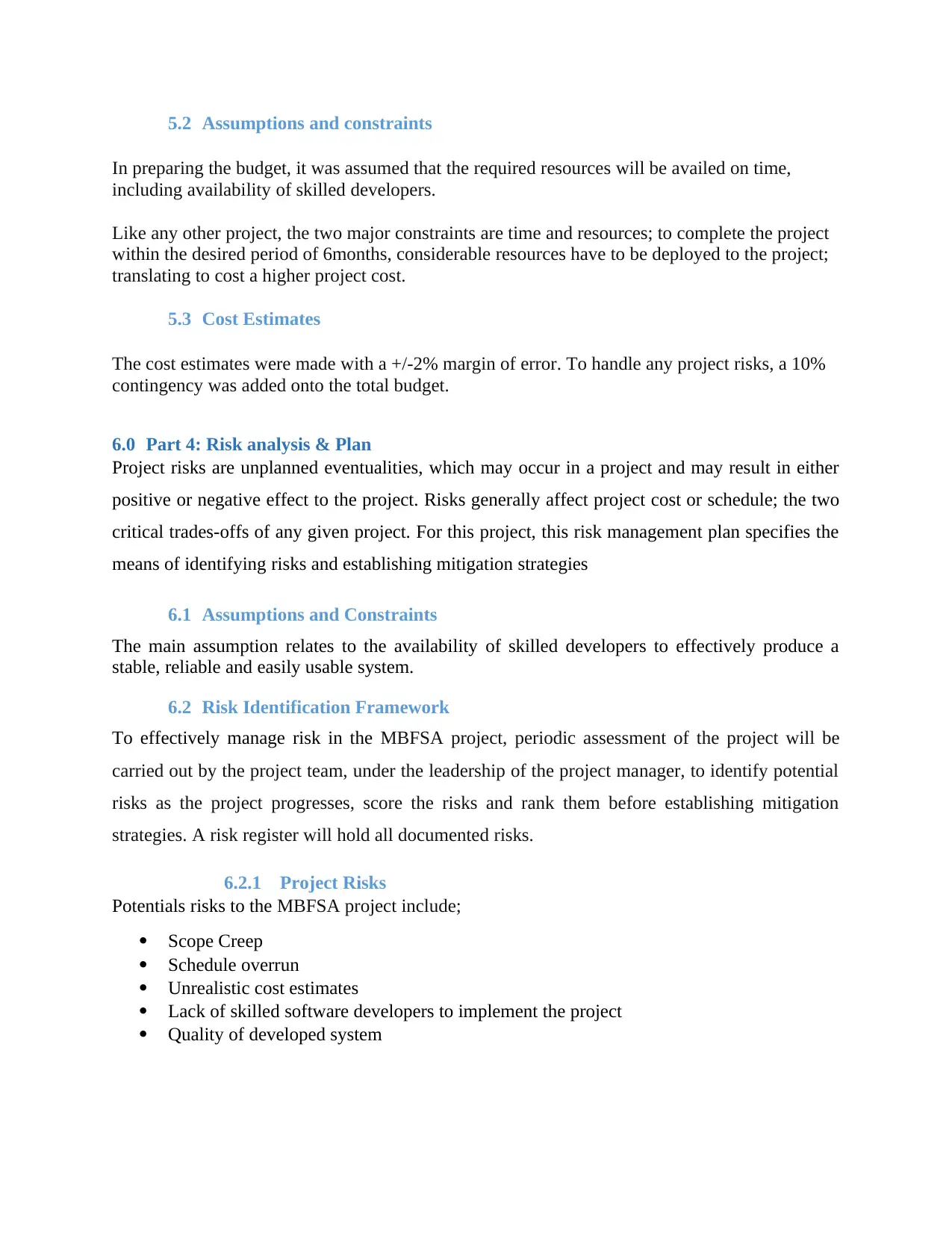
5.2 Assumptions and constraints
In preparing the budget, it was assumed that the required resources will be availed on time,
including availability of skilled developers.
Like any other project, the two major constraints are time and resources; to complete the project
within the desired period of 6months, considerable resources have to be deployed to the project;
translating to cost a higher project cost.
5.3 Cost Estimates
The cost estimates were made with a +/-2% margin of error. To handle any project risks, a 10%
contingency was added onto the total budget.
6.0 Part 4: Risk analysis & Plan
Project risks are unplanned eventualities, which may occur in a project and may result in either
positive or negative effect to the project. Risks generally affect project cost or schedule; the two
critical trades-offs of any given project. For this project, this risk management plan specifies the
means of identifying risks and establishing mitigation strategies
6.1 Assumptions and Constraints
The main assumption relates to the availability of skilled developers to effectively produce a
stable, reliable and easily usable system.
6.2 Risk Identification Framework
To effectively manage risk in the MBFSA project, periodic assessment of the project will be
carried out by the project team, under the leadership of the project manager, to identify potential
risks as the project progresses, score the risks and rank them before establishing mitigation
strategies. A risk register will hold all documented risks.
6.2.1 Project Risks
Potentials risks to the MBFSA project include;
Scope Creep
Schedule overrun
Unrealistic cost estimates
Lack of skilled software developers to implement the project
Quality of developed system
In preparing the budget, it was assumed that the required resources will be availed on time,
including availability of skilled developers.
Like any other project, the two major constraints are time and resources; to complete the project
within the desired period of 6months, considerable resources have to be deployed to the project;
translating to cost a higher project cost.
5.3 Cost Estimates
The cost estimates were made with a +/-2% margin of error. To handle any project risks, a 10%
contingency was added onto the total budget.
6.0 Part 4: Risk analysis & Plan
Project risks are unplanned eventualities, which may occur in a project and may result in either
positive or negative effect to the project. Risks generally affect project cost or schedule; the two
critical trades-offs of any given project. For this project, this risk management plan specifies the
means of identifying risks and establishing mitigation strategies
6.1 Assumptions and Constraints
The main assumption relates to the availability of skilled developers to effectively produce a
stable, reliable and easily usable system.
6.2 Risk Identification Framework
To effectively manage risk in the MBFSA project, periodic assessment of the project will be
carried out by the project team, under the leadership of the project manager, to identify potential
risks as the project progresses, score the risks and rank them before establishing mitigation
strategies. A risk register will hold all documented risks.
6.2.1 Project Risks
Potentials risks to the MBFSA project include;
Scope Creep
Schedule overrun
Unrealistic cost estimates
Lack of skilled software developers to implement the project
Quality of developed system
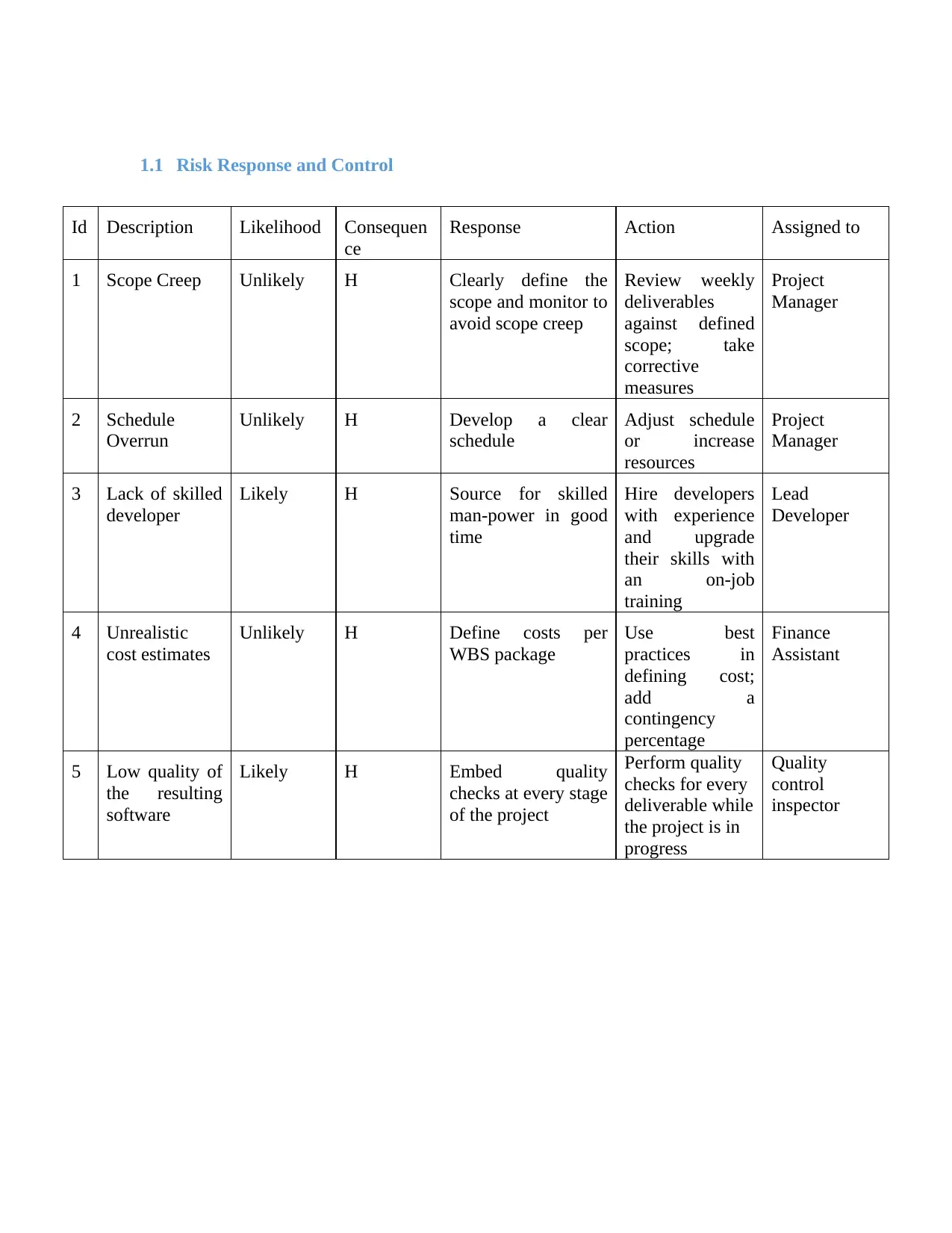
1.1 Risk Response and Control
Id Description Likelihood Consequen
ce
Response Action Assigned to
1 Scope Creep Unlikely H Clearly define the
scope and monitor to
avoid scope creep
Review weekly
deliverables
against defined
scope; take
corrective
measures
Project
Manager
2 Schedule
Overrun
Unlikely H Develop a clear
schedule
Adjust schedule
or increase
resources
Project
Manager
3 Lack of skilled
developer
Likely H Source for skilled
man-power in good
time
Hire developers
with experience
and upgrade
their skills with
an on-job
training
Lead
Developer
4 Unrealistic
cost estimates
Unlikely H Define costs per
WBS package
Use best
practices in
defining cost;
add a
contingency
percentage
Finance
Assistant
5 Low quality of
the resulting
software
Likely H Embed quality
checks at every stage
of the project
Perform quality
checks for every
deliverable while
the project is in
progress
Quality
control
inspector
Id Description Likelihood Consequen
ce
Response Action Assigned to
1 Scope Creep Unlikely H Clearly define the
scope and monitor to
avoid scope creep
Review weekly
deliverables
against defined
scope; take
corrective
measures
Project
Manager
2 Schedule
Overrun
Unlikely H Develop a clear
schedule
Adjust schedule
or increase
resources
Project
Manager
3 Lack of skilled
developer
Likely H Source for skilled
man-power in good
time
Hire developers
with experience
and upgrade
their skills with
an on-job
training
Lead
Developer
4 Unrealistic
cost estimates
Unlikely H Define costs per
WBS package
Use best
practices in
defining cost;
add a
contingency
percentage
Finance
Assistant
5 Low quality of
the resulting
software
Likely H Embed quality
checks at every stage
of the project
Perform quality
checks for every
deliverable while
the project is in
progress
Quality
control
inspector
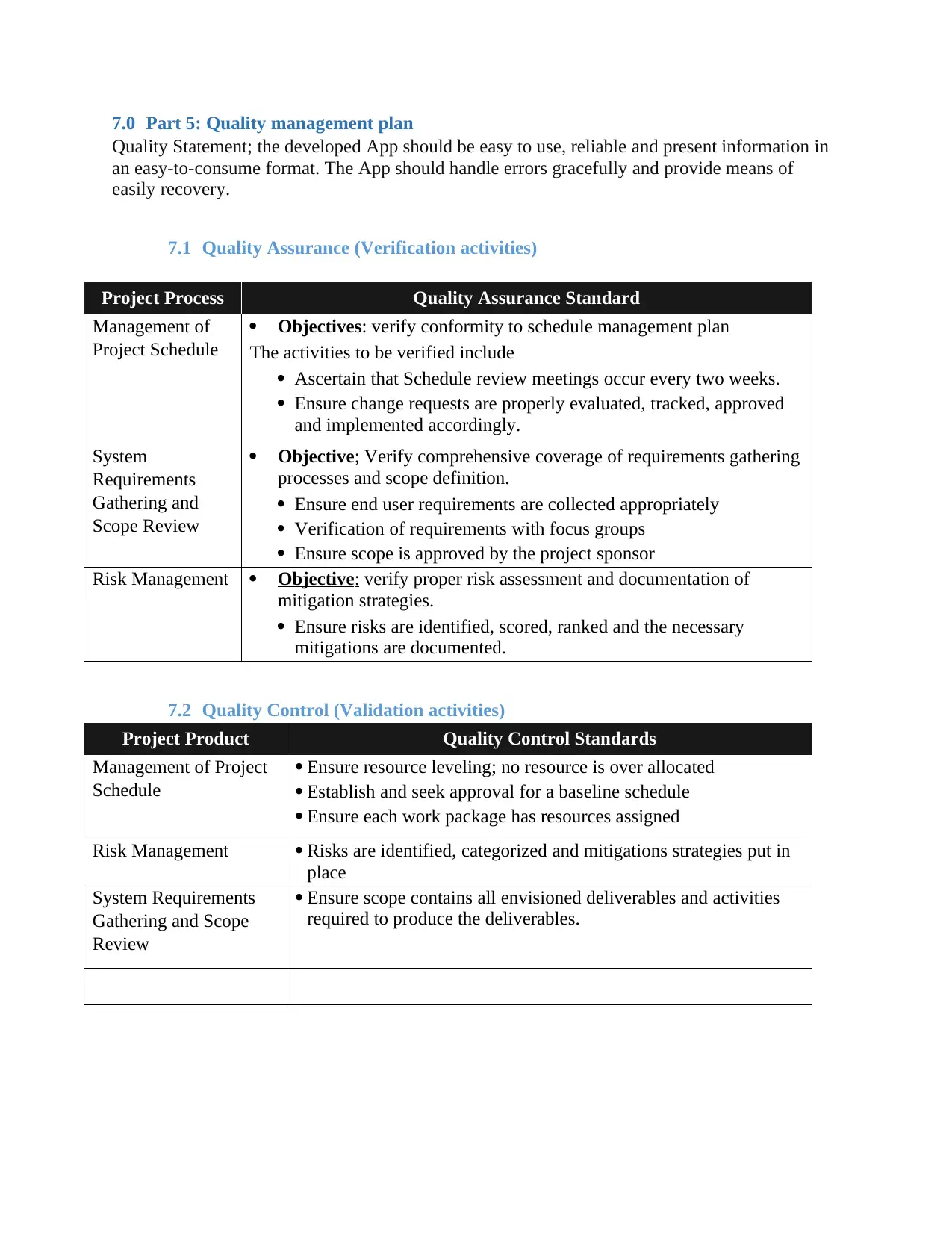
7.0 Part 5: Quality management plan
Quality Statement; the developed App should be easy to use, reliable and present information in
an easy-to-consume format. The App should handle errors gracefully and provide means of
easily recovery.
7.1 Quality Assurance (Verification activities)
Project Process Quality Assurance Standard
Management of
Project Schedule
Objectives: verify conformity to schedule management plan
The activities to be verified include
Ascertain that Schedule review meetings occur every two weeks.
Ensure change requests are properly evaluated, tracked, approved
and implemented accordingly.
System
Requirements
Gathering and
Scope Review
Objective; Verify comprehensive coverage of requirements gathering
processes and scope definition.
Ensure end user requirements are collected appropriately
Verification of requirements with focus groups
Ensure scope is approved by the project sponsor
Risk Management Objective: verify proper risk assessment and documentation of
mitigation strategies.
Ensure risks are identified, scored, ranked and the necessary
mitigations are documented.
7.2 Quality Control (Validation activities)
Project Product Quality Control Standards
Management of Project
Schedule
Ensure resource leveling; no resource is over allocated
Establish and seek approval for a baseline schedule
Ensure each work package has resources assigned
Risk Management Risks are identified, categorized and mitigations strategies put in
place
System Requirements
Gathering and Scope
Review
Ensure scope contains all envisioned deliverables and activities
required to produce the deliverables.
Quality Statement; the developed App should be easy to use, reliable and present information in
an easy-to-consume format. The App should handle errors gracefully and provide means of
easily recovery.
7.1 Quality Assurance (Verification activities)
Project Process Quality Assurance Standard
Management of
Project Schedule
Objectives: verify conformity to schedule management plan
The activities to be verified include
Ascertain that Schedule review meetings occur every two weeks.
Ensure change requests are properly evaluated, tracked, approved
and implemented accordingly.
System
Requirements
Gathering and
Scope Review
Objective; Verify comprehensive coverage of requirements gathering
processes and scope definition.
Ensure end user requirements are collected appropriately
Verification of requirements with focus groups
Ensure scope is approved by the project sponsor
Risk Management Objective: verify proper risk assessment and documentation of
mitigation strategies.
Ensure risks are identified, scored, ranked and the necessary
mitigations are documented.
7.2 Quality Control (Validation activities)
Project Product Quality Control Standards
Management of Project
Schedule
Ensure resource leveling; no resource is over allocated
Establish and seek approval for a baseline schedule
Ensure each work package has resources assigned
Risk Management Risks are identified, categorized and mitigations strategies put in
place
System Requirements
Gathering and Scope
Review
Ensure scope contains all envisioned deliverables and activities
required to produce the deliverables.
Secure Best Marks with AI Grader
Need help grading? Try our AI Grader for instant feedback on your assignments.
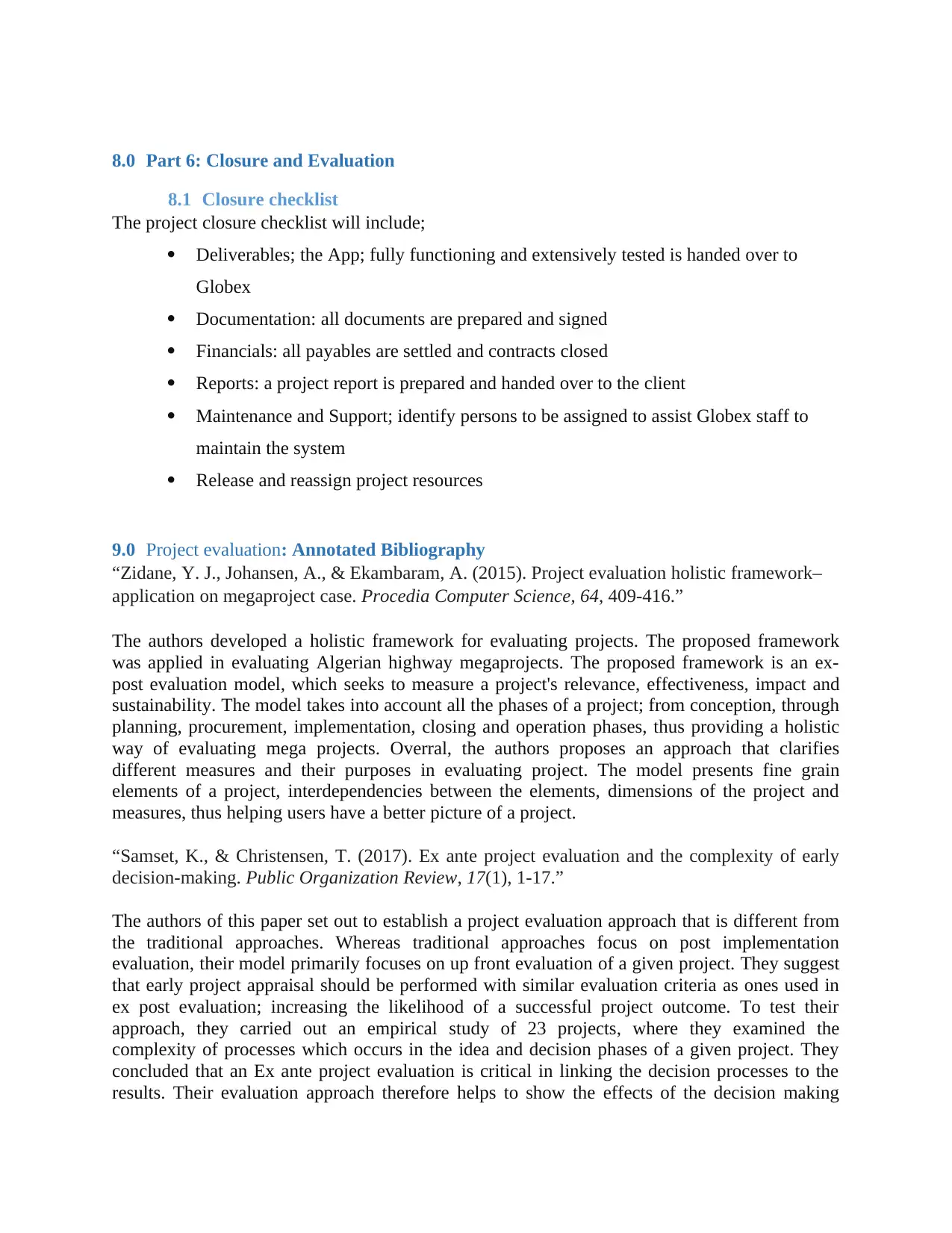
8.0 Part 6: Closure and Evaluation
8.1 Closure checklist
The project closure checklist will include;
Deliverables; the App; fully functioning and extensively tested is handed over to
Globex
Documentation: all documents are prepared and signed
Financials: all payables are settled and contracts closed
Reports: a project report is prepared and handed over to the client
Maintenance and Support; identify persons to be assigned to assist Globex staff to
maintain the system
Release and reassign project resources
9.0 Project evaluation: Annotated Bibliography
“Zidane, Y. J., Johansen, A., & Ekambaram, A. (2015). Project evaluation holistic framework–
application on megaproject case. Procedia Computer Science, 64, 409-416.”
The authors developed a holistic framework for evaluating projects. The proposed framework
was applied in evaluating Algerian highway megaprojects. The proposed framework is an ex-
post evaluation model, which seeks to measure a project's relevance, effectiveness, impact and
sustainability. The model takes into account all the phases of a project; from conception, through
planning, procurement, implementation, closing and operation phases, thus providing a holistic
way of evaluating mega projects. Overral, the authors proposes an approach that clarifies
different measures and their purposes in evaluating project. The model presents fine grain
elements of a project, interdependencies between the elements, dimensions of the project and
measures, thus helping users have a better picture of a project.
“Samset, K., & Christensen, T. (2017). Ex ante project evaluation and the complexity of early
decision-making. Public Organization Review, 17(1), 1-17.”
The authors of this paper set out to establish a project evaluation approach that is different from
the traditional approaches. Whereas traditional approaches focus on post implementation
evaluation, their model primarily focuses on up front evaluation of a given project. They suggest
that early project appraisal should be performed with similar evaluation criteria as ones used in
ex post evaluation; increasing the likelihood of a successful project outcome. To test their
approach, they carried out an empirical study of 23 projects, where they examined the
complexity of processes which occurs in the idea and decision phases of a given project. They
concluded that an Ex ante project evaluation is critical in linking the decision processes to the
results. Their evaluation approach therefore helps to show the effects of the decision making
8.1 Closure checklist
The project closure checklist will include;
Deliverables; the App; fully functioning and extensively tested is handed over to
Globex
Documentation: all documents are prepared and signed
Financials: all payables are settled and contracts closed
Reports: a project report is prepared and handed over to the client
Maintenance and Support; identify persons to be assigned to assist Globex staff to
maintain the system
Release and reassign project resources
9.0 Project evaluation: Annotated Bibliography
“Zidane, Y. J., Johansen, A., & Ekambaram, A. (2015). Project evaluation holistic framework–
application on megaproject case. Procedia Computer Science, 64, 409-416.”
The authors developed a holistic framework for evaluating projects. The proposed framework
was applied in evaluating Algerian highway megaprojects. The proposed framework is an ex-
post evaluation model, which seeks to measure a project's relevance, effectiveness, impact and
sustainability. The model takes into account all the phases of a project; from conception, through
planning, procurement, implementation, closing and operation phases, thus providing a holistic
way of evaluating mega projects. Overral, the authors proposes an approach that clarifies
different measures and their purposes in evaluating project. The model presents fine grain
elements of a project, interdependencies between the elements, dimensions of the project and
measures, thus helping users have a better picture of a project.
“Samset, K., & Christensen, T. (2017). Ex ante project evaluation and the complexity of early
decision-making. Public Organization Review, 17(1), 1-17.”
The authors of this paper set out to establish a project evaluation approach that is different from
the traditional approaches. Whereas traditional approaches focus on post implementation
evaluation, their model primarily focuses on up front evaluation of a given project. They suggest
that early project appraisal should be performed with similar evaluation criteria as ones used in
ex post evaluation; increasing the likelihood of a successful project outcome. To test their
approach, they carried out an empirical study of 23 projects, where they examined the
complexity of processes which occurs in the idea and decision phases of a given project. They
concluded that an Ex ante project evaluation is critical in linking the decision processes to the
results. Their evaluation approach therefore helps to show the effects of the decision making
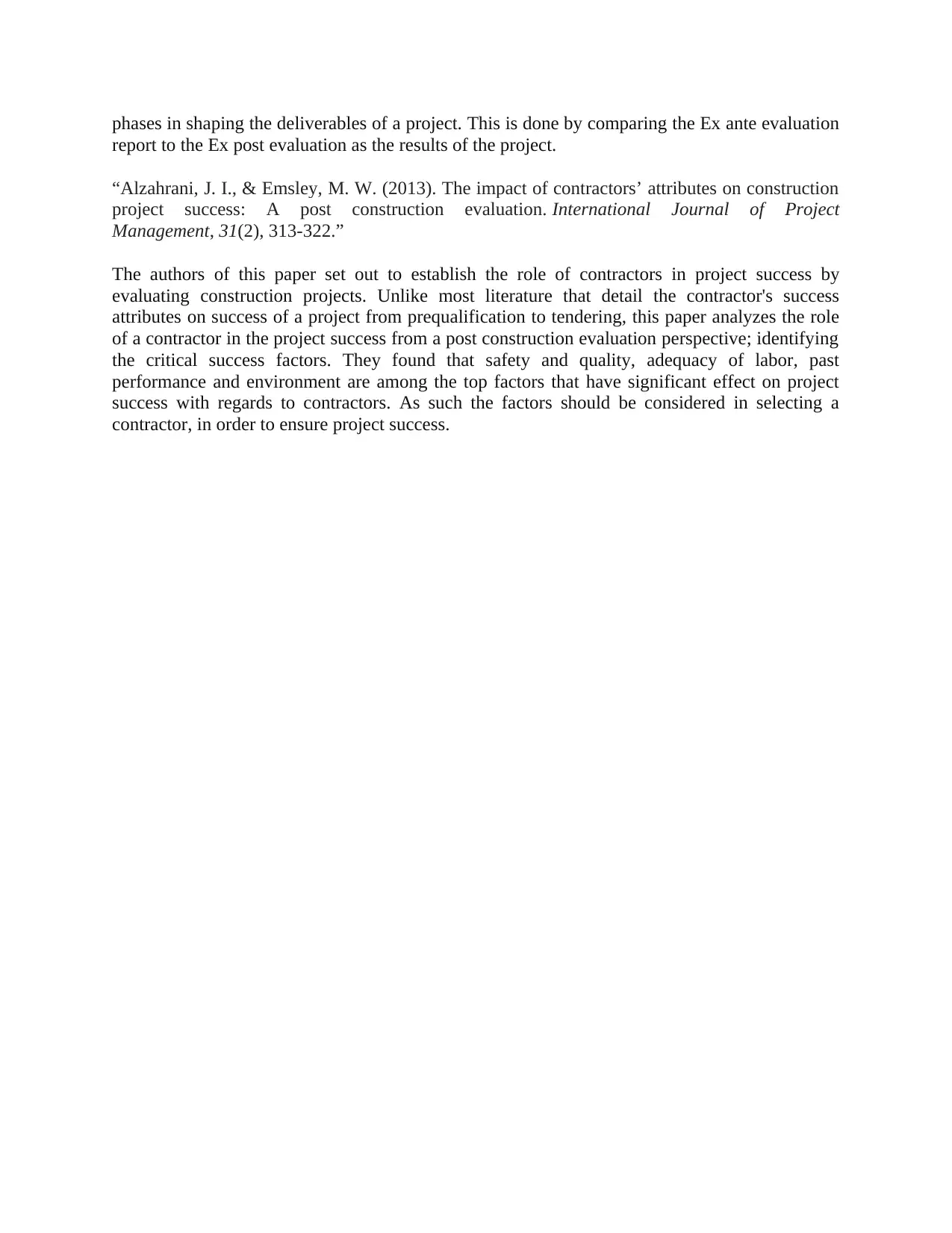
phases in shaping the deliverables of a project. This is done by comparing the Ex ante evaluation
report to the Ex post evaluation as the results of the project.
“Alzahrani, J. I., & Emsley, M. W. (2013). The impact of contractors’ attributes on construction
project success: A post construction evaluation. International Journal of Project
Management, 31(2), 313-322.”
The authors of this paper set out to establish the role of contractors in project success by
evaluating construction projects. Unlike most literature that detail the contractor's success
attributes on success of a project from prequalification to tendering, this paper analyzes the role
of a contractor in the project success from a post construction evaluation perspective; identifying
the critical success factors. They found that safety and quality, adequacy of labor, past
performance and environment are among the top factors that have significant effect on project
success with regards to contractors. As such the factors should be considered in selecting a
contractor, in order to ensure project success.
report to the Ex post evaluation as the results of the project.
“Alzahrani, J. I., & Emsley, M. W. (2013). The impact of contractors’ attributes on construction
project success: A post construction evaluation. International Journal of Project
Management, 31(2), 313-322.”
The authors of this paper set out to establish the role of contractors in project success by
evaluating construction projects. Unlike most literature that detail the contractor's success
attributes on success of a project from prequalification to tendering, this paper analyzes the role
of a contractor in the project success from a post construction evaluation perspective; identifying
the critical success factors. They found that safety and quality, adequacy of labor, past
performance and environment are among the top factors that have significant effect on project
success with regards to contractors. As such the factors should be considered in selecting a
contractor, in order to ensure project success.
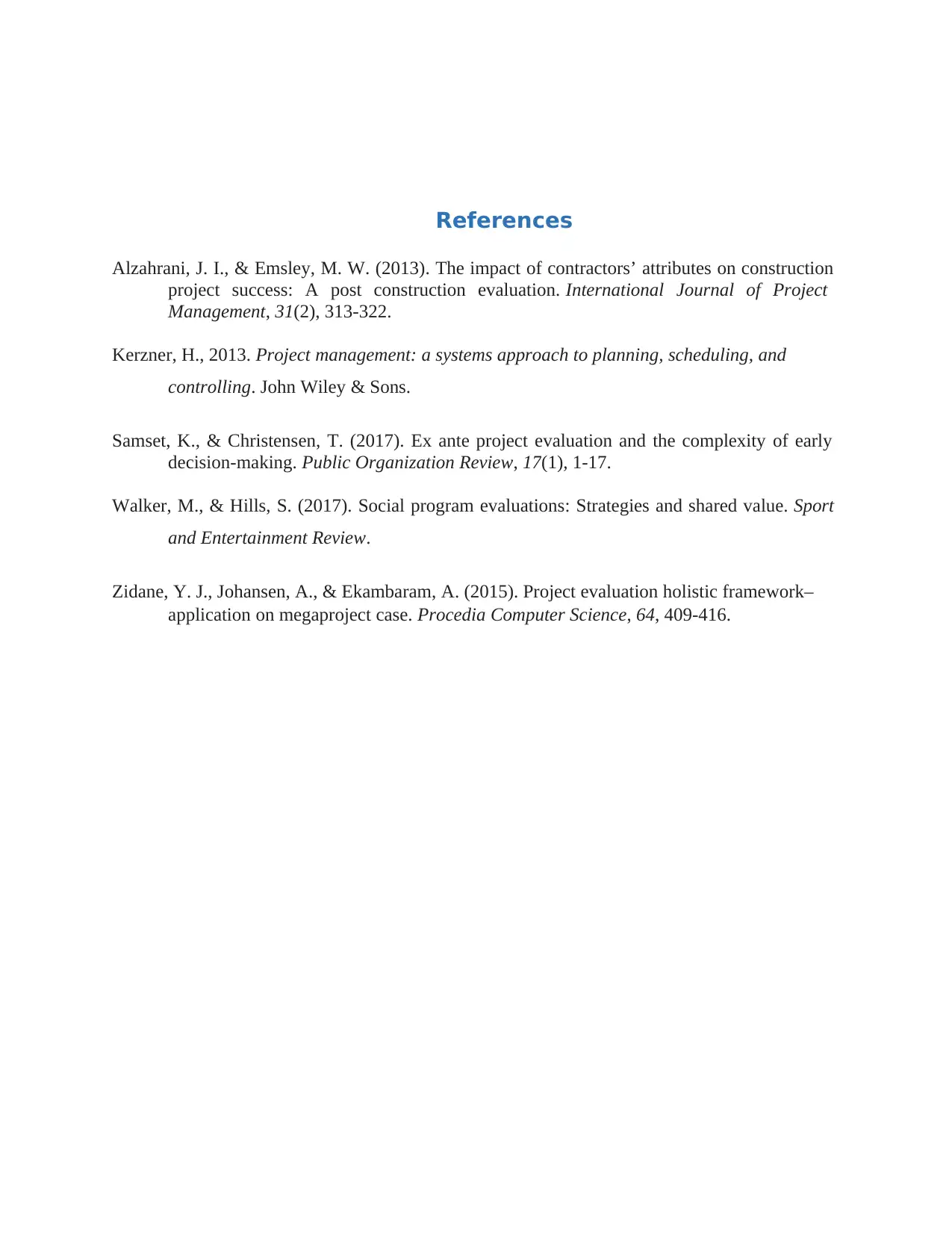
References
Alzahrani, J. I., & Emsley, M. W. (2013). The impact of contractors’ attributes on construction
project success: A post construction evaluation. International Journal of Project
Management, 31(2), 313-322.
Kerzner, H., 2013. Project management: a systems approach to planning, scheduling, and
controlling. John Wiley & Sons.
Samset, K., & Christensen, T. (2017). Ex ante project evaluation and the complexity of early
decision-making. Public Organization Review, 17(1), 1-17.
Walker, M., & Hills, S. (2017). Social program evaluations: Strategies and shared value. Sport
and Entertainment Review.
Zidane, Y. J., Johansen, A., & Ekambaram, A. (2015). Project evaluation holistic framework–
application on megaproject case. Procedia Computer Science, 64, 409-416.
Alzahrani, J. I., & Emsley, M. W. (2013). The impact of contractors’ attributes on construction
project success: A post construction evaluation. International Journal of Project
Management, 31(2), 313-322.
Kerzner, H., 2013. Project management: a systems approach to planning, scheduling, and
controlling. John Wiley & Sons.
Samset, K., & Christensen, T. (2017). Ex ante project evaluation and the complexity of early
decision-making. Public Organization Review, 17(1), 1-17.
Walker, M., & Hills, S. (2017). Social program evaluations: Strategies and shared value. Sport
and Entertainment Review.
Zidane, Y. J., Johansen, A., & Ekambaram, A. (2015). Project evaluation holistic framework–
application on megaproject case. Procedia Computer Science, 64, 409-416.
1 out of 13
Related Documents
Your All-in-One AI-Powered Toolkit for Academic Success.
+13062052269
info@desklib.com
Available 24*7 on WhatsApp / Email
![[object Object]](/_next/static/media/star-bottom.7253800d.svg)
Unlock your academic potential
© 2024 | Zucol Services PVT LTD | All rights reserved.





